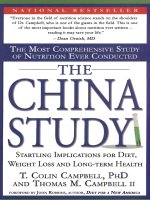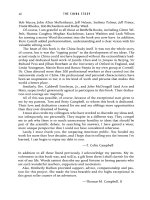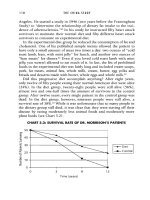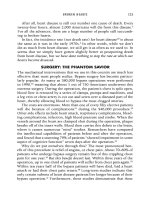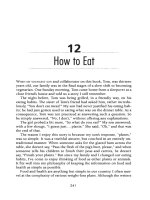66 the china study the most comprehensive phần 24
Bạn đang xem bản rút gọn của tài liệu. Xem và tải ngay bản đầy đủ của tài liệu tại đây (66.25 KB, 5 trang )
LESSONS FROM CHINA
103
men and 11 for women).6l However, this effect was primarily attributed
to plant protein, because it makes up 90% of the total Chinese protein
intake. Animal protein consumption was indeed associated with greater
body weight,l and consumption of protein-rich milk seemed to be effective as well.1! But the good news is this: Greater plant protein intake was
closely linked to greater heightIl and body weightY Body growth is linked
to protein in general and both animal and plant proteins are effective!
This means that individuals can achieve their genetic potential for
growth and body size by consuming a plant-based diet. So why is it that
people in developing nations, who consume little or no animal-based
foods, are consistently smaller than Western people? This is because
plant-based diets in poor areas of the world usually have insufficient
variety, inadequate quantity and quality and are associated with poor
public health conditions where childhood diseases are prevalent. Under
these conditions, growth is stunted and people do not reach their genetic potential for adult body size. In the China Study, low adult height
and weight were strongly associated with areas having high mortality
rates for pulmonary tuberculosis,IIl parasitic diseases,JIl pneumonia (Ill
for height) , "intestinal obstruction"m and digestive diseases. III
These findings support the idea that body stature can be achieved
by consuming a low-fat, plant-based diet, provided that public health
conditions effectively control the diseases of poverty. Under these conditions, the diseases of affluence (heart disease, cancers, diabetes, etc.)
can be simultaneously minimized.
The same low-animal protein, low-fat diet that helps prevent obesity
also allows people to reach their full growth potential while working
other wonders as well. It better regulates blood cholesterol and reduces
heart disease and a variety of cancers.
What are the odds that all of these associations (and many others)
favoring a plant-based diet are due to pure chance? It is extremely unlikely, to say the least. Such consistency of evidence across a broad range
of associations is rare in scientific research. It points to a new worldview,
a new paradigm. It defies the status quo, promises new health benefits
and demands our attention.
104
THE CHINA STUDY
CIRCLING BACK
In the beginning of my career, I concentrated on the biochemical processes of liver cancer. Chapter three delineates the decades-long laboratory work we did with experimental animals, work that passed the
requirements to be called "good science." The finding: casein, and very
likely all animal proteins, may be the most relevant cancer-causing substances that we consume. Adjusting the amount of dietary casein has
the power to turn on and turn off cancer growth, and to override the
cancer-producing effects of aflatoxin, a very potent Class IA carcinogen,
but even though these findings were substantially confirmed, they still
applied to experimental animals.
It was therefore with great anticipation that I looked to the China
Study for evidence on the causes of liver cancer in humans. 62
Liver cancer rates are very high in rural China, exceptionally high in
some areas. Why was this? The primary culprit seemed to be chronic
infection with hepatitis B virus (HBV). On average, about 12-13% of our
study subjects were chronically infected with the virus. In some areas,
one-half of the people were chronically infected! To put this into perspective, only 0.2-0.3% of Americans are chronically infected with this virus.
But there's more. In addition to the virus being a cause of liver cancer
in China, it seems that diet also plays a key role. How do we know? The
blood cholesterol levels provided the main clue. Liver cancer is strongly
associated with increasing blood cholesterol,III and we already know
that animal-based foods are responsible for increases in cholesterol.
So, where does HBV fit in? The experimental mice studies gave a
good signal. In mice, HBV initiated the liver cancer but the cancer grew
in response to the feeding of higher levels of casein. In addition, blood
cholesterol also increased. These observations fit perfectly with our human findings. Individuals who are chronically infected with HBV and
who consume animal-based foods have high blood cholesterol and a
high rate of liver cancer. The virus provides the gun, and bad nutrition
pulls the trigger.
A very exciting story was taking shape, at least to my way of thinking. It was a story full of meaning and suggestive of important principles
that might apply to other diet and cancer associations. It also was a
story that had not been told to the public, and yet it was capable of saving lives. Eventually, it was a story that was leading to the idea that our
most powerful weapon against cancer is the food we eat every day.
LESSONS FROM CHINA
105
So there we had it. The years of animal experiments illuminated
profound biochemical principles and processes that greatly helped to
explain the effect of nutrition on liver cancer. But now we could see that
these processes were relevant for humans as well. People chronically
infected with hepatitis B virus also had an increased risk of liver cancer.
But our findings suggested those who were infected with the virus and
who were simultaneously eating more animal-based foods had higher
cholesterol levels and more liver cancer than those infected with the
virus and not consuming animal-based foods. The experimental animal
studies and the human studies made a perfect fit.
PULLING IT TOGETHER
Almost all of us in the United States will die of diseases of affluence. In
our China Study, we saw that nutrition has a very strong effect on these
diseases. Plant-based foods are linked to lower blood cholesterol; animal-based foods are linked to higher blood cholesterol. Animal-based
foods are linked to higher breast cancer rates; plant-based foods are
linked to lower rates. Fiber and antioxidants from plants are linked to a
lower risk of cancers of the digestive tract. Plant-based diets and active
lifestyles result in a healthy weight, yet permit people to become big and
strong. Our study was comprehensive in design and comprehensive in
its findings. From the labs of Virginia Tech and Cornell University to the
far reaches of China, it seemed that science was painting a clear, consistent picture: we can minimize our risk of contracting deadly diseases
just by eating the right food .
When we first started this project we encountered significant resistance from some people. One of my colleagues at Cornell, who had been
involved in the early planning of the China Study, got quite heated in
one of our meetings. I had put forth the idea of investigating how lots of
dietary factors, some known but many unknown, work together to cause
disease. Thus we had to measure lots of factors, regardless of whether or
not they were justified by prior research. If that was what we intended to
do, he said he wanted nothing to do with such a "shotgun" approach.
This colleague was expressing a view that was more in line with
mainstream scientific thought than with my idea. He and like-minded
colleagues think that science is best done when investigating singlemostly known-factors in isolation. An array of largely unspecified factors doesn't show anything, they say. It's okay to measure the specific
effect of, say, selenium on breast cancer, but it's not okay to measure
106
THE CHINA STUDY
multiple nutritional conditions in the same study, in the hope of identifying important dietary patterns.
I prefer the broader picture, for we are investigating the incredible
complexities and subtleties of nature itself. I wanted to investigate how
dietary patterns related to disease, now the most important point of this
book. Everything in food works together to create health or disease. The
more we think that a single chemical characterizes a whole food, the
more we stray into idiocy. As we shall see in Part IV of this book, this
way of thinking has generated a lot of poor science.
So I say we need more, not less, of the "shotgun approach." We need
more thought about overall dietary patterns and whole foods. Does this
mean that I think the shotgun approach is the only way to do research?
Of course not. Do I think that the China Study findings constitute absolute scientific proof? Of course not. Does it provide enough information
to inform some practical decision-making? Absolutely.
An impressive and informative web of information was emerging
from this study. But does every potential strand (or association) in this
mammoth study fit perfectly into this web of information? No. Although
most statistically significant strands readily fit into the web, there were a
few surprises. Most, but not all, have since been explained.
Some associations observed in the China Study, at first glance, were
at odds with what might have been expected from Western experience.
I've had to use care in separating unusual findings that could be due
to chance and experimental insufficiency from those that truly offered
new insights into our old ways of thinking. As I mentioned earlier, the
range of blood cholesterol levels in rural China was a surprise. At the
time when the China Study was begun, a blood cholesterol range of
200-300 milligrams per deciliter (mgldL) was considered normal, and
lower levels were suspect. In fact, some in the scientific and medical
communities considered cholesterol levels lower than 150 mgldL to be
dangerous. In fact, my own cholesterol was 260 mgldL in the late 1970s,
not unlike other members of my immediate family. The doctor told me
it was "fine, just average."
But when we measured the blood cholesterol levels in China, we
were shocked. They ranged from 70-170 mgldL! Their high was our
low, and their low was off the chart you might find in your doctor's
office! It became obvious that our idea of "normal" values (or ranges)
only applies to Western subjects consuming the Western diet. It so
happens, for example, that our "normal" cholesterol levels present a
LESSONS FROM CHINA
107
significant risk for heart disease. Sadly, it's also "normal" to have heart
disease in America. Over the years, standards have been established that
are consistent with what we see in the West. We too often have come to
the view that u.s. values are "normal" because we have a tendency to
believe that the Western experience is likely to be right.
At the end of the day, the strength and consistency of the majority
of the evidence is enough to draw valid conclusions. Namely, whole,
plant-based foods are beneficial, and animal-based foods are not. Few
other dietary choices, if any, can offer the incredible benefits of looking
good, growing tall and avoiding the vast majority or premature diseases
in our culture.
The China Study was an important milestone in my thinking. Standing
alone, it does not prove that diet causes disease. Absolute proof in science
is nearly unattainable. Instead, a theory is proposed and debated until the
weight of the evidence is so overwhelming that everyone commonly accepts that the theory is most likely true. In the case of diet and disease, the
China Study adds a lot of weight to the evidence. Its experimental features
(multiple diet, disease and lifestyle characteristics, and unusual range of
dietary experience, a good means of measuring data quality) provided an
unparalleled opportunity to expand our thinking about diet and disease
in ways that previously were not available. It was a study that was like a
flashlight that illuminated a path that I had never fully seen before.
The results of this study, in addition to a mountain of supporting
research, some of it my own and some of it from other scientists, convinced me to turn my dietary lifestyle around. I stopped eating meat
fifteen years ago , and I stopped eating almost all animal-based foods,
including dairy, within the past six to eight years, except on very rare
occasions. My cholesterol has dropped, even as I've aged; I am more
physically fit now than when I was twenty-five; and I am forty-five
pounds lighter now than I was when I was thirty years old. I am now at
an ideal weight for my height. My family has also adopted this way of
eating, thanks in large part to my wife Karen, who has managed to create
an entire new dietary lifestyle that is attractive, tasty and healthy. This
has all been done for health reasons, the result of my research findings
telling me to wake up. From a boyhood of drinking at least two quarts
of milk a day to an early professional career of scoffing at vegetarians, I
have taken an unusual turn in my life.
However, it has been more than my own research that has changed
my life. Over the years, I have gone well beyond our own research find-
